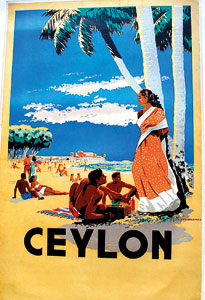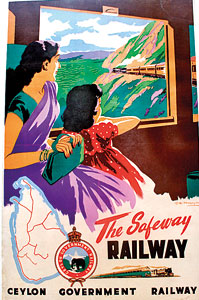Only an extraordinarily creative and enterprising person would collect and publish a massive array of posters of Ceylon. Anura Saparamadu, who created his unputdownable autobiographical first novel 'When life gives you lemons, make limonocello', a couple of years ago, is that person. The blurb on the dust jacket said it was "his first and probably last novel", but one hoped that would not be so.
And now, mercifully, there is his magnificent coffee table book weighing one kilogram, with 256 pages of colour reproductions of some 300 vintage Ceylon posters that he had collected as a hobby over the past five years. They are posters of Ceylon, not Sri Lanka (and all the more precious for their historic value) since they are pre-1972 when the island nation reverted to its Sinhala name after centuries of foreign domination.
Some of the posters featured in this volume have cost the author large amounts of money ranging from several thousands like the Sinhala movie posters to thousands of dollars like the hand-drawn silk-screened ones by C. K. L. Samarasinha or G. S. Fernando. He had bought these items from antique dealers both in Sri Lanka and abroad, if evidence be needed of a rare, almost unique, preoccupation of a collector. The price of posters can vary and for example, airline and travel posters are highly collectible and cost a lot more than others like tea or consumer goods.
"Vintage posters run from a few dollars to thousands of dollars depending on the rarity and desirability of the poster. Not surprisingly, hand drawn Ceylon posters from the 1930s and '40s are highly collectible amongst collectors all over the world who specialize in travel and airline and cruise ship liners.
For example, posters by C.K.L. Samarasinha go for thousands of dollars whereas a Sinhala movie poster will sell for about Rs. 2000. I am in touch with every major poster dealer in the world and have requested them for 'Ceylon' posters. I have also bought posters through antique dealers both in Sri Lanka and abroad. Some posters I bought on the internet but now it is quite rare to find unique posters on the net as most of what is available, I already have," says Saparamadu.
Ilustrations of captivating imagery unfold page after page, taking the reader back some 150 years. Rich in texture and colour, they both delight and surprise the senses. Over time, a fascination with these works of art turned Saparamadu into a serious collector. His friends persuaded him to compile his impressive collection and a beautiful book is the happy outcome: "a feast of abstract images, striking composition, and fine detail greets the eye as prints, renderings, and lithographs journey through a Ceylon long-forgotten, but forever loved".
Superbly produced, the book is divided into seven categories that cover a range of themes. The reader is bound to find a category he can personally relate to: tea, travel, war, cinema, government, and consumer goods. A miscellany includes subjects that cannot be subsumed under any of these categories.
Reinforcing the value of the posters and their meaning are Saparamadu's beautifully crafted essays on the seven themes of the posters. They are vignettes, nay monuments, of English prose. Savour, for example, his historical narrative, as crisp as the dried and two leaves and a bud, on tea -a topic close to the Sri Lankan heart:
When coffee plantations in Ceylon were devastated by the coffee rust disease during the middle of the 19th century, plantation owners turned to tea as an alternative crop. Loolecondera, the first commercial estate, was planted in 1867 and the first recorded shipment of tea came five years later in 1872…
John Lane Denham of Croydon was one of the first to sell tea in retail packets under his own brand name. In 1887,(he) registered the brand "Mazawattee' based on the words 'mazaa', which means pleasure or fun in Hindi, and the Sinhalese 'watta', a garden. Densham began using posters with an image of an aged, bespectacled grandma with her granddaughter to promote the Mazawattee brand. Before long, the name Mazawattee was everywhere and the painting, known as 'Old Folks at Home' (Poster No. 40) had become synonymous with the brand.
On the history of tourism, from Saparamadu's pen flow this succinct story:
The latter part of the 19th century and the first two decades of the 20th century brought about giant technological improvements in transportation. Railroads, ocean liners, automobiles, and airplanes became affordable modes of travel. Whereas travelling to the far corners of the earth had previously been the domain of explorers, fortune seekers, and colonial civil servants, the transport revolution enabled ordinary people to travel great distances in comfort and at reasonable cost. This new found freedom to explore the world sparked a new type of traveller: the tourist. The era of travel for pleasure had dawned. By the 1920s tourism was a fast growing business with luxury cruise liners offering trips to exotic locales in far away lands.
Tourist posters highlighted the island's attractions and poster competitions were common. Two artists of renown, C. K. L. Samarasinha and G. S Fernando, stole the show. Their winning designs are the best known travel posters from the postwar era.
"War" is the setting for some of the most striking posters in Saparamadu's collection. He deftly weaves the story of the poster into the story of war. "The war that rode on revolutionary fervour was promoted by poster-based imagery," he says, giving a poetic touch to the prosaic business of war and posters.
With the outbreak of the First World War in 1914, the poster became a critical communication tool in recruiting soldiers and raising funds for the war effort. It is estimated that America alone created more than 2,500 war posters and printed more than 20 million copes from 1917-1918. An outstanding example is James Montgomery Flagg's famous US army recruiting poster of Uncle Sam pointing his finger directly at the viewer, a patriotic call to arms (p. 85).
The role in the war effort played by Sir Ivor Jennings, who arrived in Ceylon in 1941 to create a university for the Crown Colony, is recalled with gratitude. (A charming black and white photograph of Jennings flanked by the author's parents in their university days on page 90 adds to the value to the book.)
A survivor of Dunkirk, Jennings was troubled by the lack of commitment to the war effort in Ceylon. At the time, the only action the Ceylon State Council had taken was to pass a resolution to close schools. However, Jennings soon impressed government officials on what they should be doing to get Ceylon ready for a Japanese attack and Governor Sir Andrew Caldecott summoned Jennings to preside over the War Publicity Committee.
He began several initiatives to make the people of Ceylon a part of the war effort. The War Savings Bond Movement, the Campaign to Increase Production, and the Grow More Food Campaign were some of his ideas. Jennings was also the creator of 'Looting is Punishable with Death', a well-known war poster which was plastered all over Colombo. (Sooty Banda's poster with just two words 'Grow More" won an award, we remember.)
'Join the Royal Ceylon Navy Full particulars from nearest Kachcheri, Police Station, Post Office, DRO's Office', 'Careless talk spreads panic', 'Careless words cost lives,' "Careless words kill', 'Victory Volunteer Centres Back them Up', 'Your Mobile Canteen in Action, Thank you, Ceylon!' 'Your Hurricanes in Action, Thank you, Ceylon!', 'Don't Throw us Away! Salvage. We are wanted on the war effort', 'Lanka calling Young Men of Ceylon Your country needs you now, Join the Army now', and 'Join the Ceylon Engineers Become a Soldier Tradesman' are some of Saparamadu's wartime posters that revive memories of our schooldays.
Vintage Posters of Ceylon is a coffee table book of grandeur, uniqueness and information to take down and slowly read as the mood takes you. Not too much at a single gulp lest the appetite cloy especially of those who remember and lived in the times the posters portray. One awaits the second coffee book table on Vintage Posters of Sri Lanka of a time when not a single bare wall was spared. |



